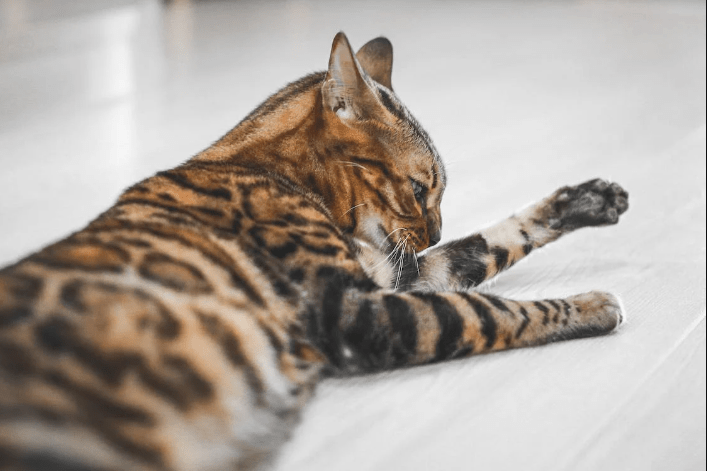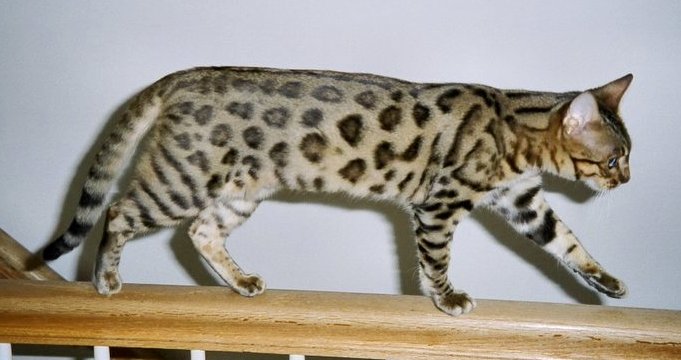The Bengal cat is a domestic breed that is developed to appear like exotic wild cats such as leopards, ocelots, clouded leopards, and margays. They were developed through selective breeding from hybrids of the Asian leopard cat with domestic cats with the goal of creating a friendly, confident, and healthy cat that has a contrasted and vividly marked coat. This cat breed is loved by people who appreciate its inquisitive and loving nature. Let us know more about the history and characteristics of the Bengal cat breed.
History
The Bengal cat was originally named as the Leopardette. It’s a hybridization of domestic cats and Asian leopard cats. The name Bengal was taken from the Asian leopard cat’s scientific name which is Felis bengalensis. Bengal cats in the 1950s and into the 1960s could be purchased at pet stores.
The first to make such a cross was Jean Mill but not because she wanted to develop a new breed, but because she acquired a leopard cat and allowed it to be accompanied by a black tom cat so it would not be lonely. Jean Mill hadn’t thought that the two would mate and to her surprise, it resulted to kittens and she kept a spotted female. She bred it back to its father which produced a litter of spotted and solid kittens.
About the same time, Dr. Willard Centerwall also crossed leopard cats with domestic cats at Loyola University. It was because leopard cats were resistant to the feline leukemia virus and researchers were interested to find out if the trait could be passed on to hybrid offspring.
A lot of breeders became interested in developing the cats as a breed and Jean Mill was one of them. She acquired some of the hybrids of Dr. Centerwall and sought out suitable male cats to breed to them. One was an orange domestic shorthair from India, and the other was a brown spotted tabby that came from a shelter.
Today, Bengals are considered to be one and the same with domestic cats. Any Bengals purchased must be at least four generations removed from any ancestors with wild bloodlines. The Bengal was recognized by the International Cat Association and granted it the breed experimental status in 1983 and a full recognition in 1991. The breed was also recognized by the American Cat Fanciers Association, the Canadian Cat Association, and the United Feline Organization. It was a sought after breed and in fact, in 1990, a British woman paid more than fifty thousand dollars for her Bengal cat which dubbed them the “Rolls Royce” of feline companions.
Characteristics of a Bengal Cat
Average weight: 8 – 15 pounds
Life span: 10 – 16 years
Hypoallergenic: Yes
Bengal cats are beautiful and wild-looking. Male Bengals can weigh from 10 to 15 pounds while females can weigh from 8 to 12 pounds. They have shorthair with spotted or marbled coats and patterns outlined in black, brown, or grey. The Bengal cat has a broad head in a modified wedge shape that is longer that its wide and rounded contours. It has small ears that are short and are set toward the side of the head. They have large, oval eyes that are almost round and a long, muscular neck.
The legs of a Bengal cat are medium in length, slightly longer in the back compared to the front, and they have large, round paws. Its tail is thick and has a medium length that tapers at the end and is tipped in black. It also has a spotted belly which enhances the wild appearance of the bread. Bengal cats come in different colors and patterns such as brown, seal, tabby, black silver tabby, and seal silver lynx point. Their coats can be randomly sported or it can also be marbled with horizontal stripes arranged randomly on a lighter background. There are also some Bengals that have glittered coats where the fur shimmers in the light as if it was sprinkled with gold dust.
Bengal cats are highly active and intelligent pets, making them fun to live with. It is a talkative, confident, and friendly cat that is always attentive. In fact, nothing escapes its notice. They love their people and they will do anything to get their attention. They are a great choice for families with older children who will enjoy playing with them and as well as with cat-friendly dogs. They can get along with other pets as well but remember that they have a high prey drive and should not be trusted with smaller animals and pets like rabbits, guinea pigs, and hamsters.
Caring for a Bengal Cat
Bengal cats have short, soft, and luxurious coat that is very easy to take care of simply with weekly brushing. They will surely love the attention, and brushing them regularly will help you minimize the dust bunnies and hairballs in your home. The rest of the grooming needs of Bengals are basic care such as trimming their nails as needed, checking their ears for dirt and redness, and brushing their teeth frequently.
Always remember to keep their litter box clean because they are very particular about bathroom hygiene. A dirty litter box might urge them to use other parts of your home. Bengal cats are also indoor-only type of cats because letting them go out can make them prone to diseases from other cats, harm by other animals, and they might get hit by a car as well. But since they are active cats, it’s important to provide them a wider space at home or build them a large outdoor enclosure where it can jump and climb safely.
When it comes to food, feeding Bengal cats high protein foods is a must. Most commercial cat foods today contain less meat and more carbohydrates and if you often give your Bengal a diet that consists mostly of low-grade commercial foods, it might lead to health issues in the future. Therefore, more than feeding them commercial cat foods, it’s important to provide them fresh, raw meat as well. You need to make sure that the protein in your pet’s diet is about fifty to eighty percent, leaving room for fiber and vitamins. It’s better to consult with your local vet on how you can optimize your Bengal’s diet.
Bengal cats are perfect for active people who are looking for a playful companion. If you have older kids at home who love cats, then the graceful and active Bengal cat might be the perfect family pet for you.


